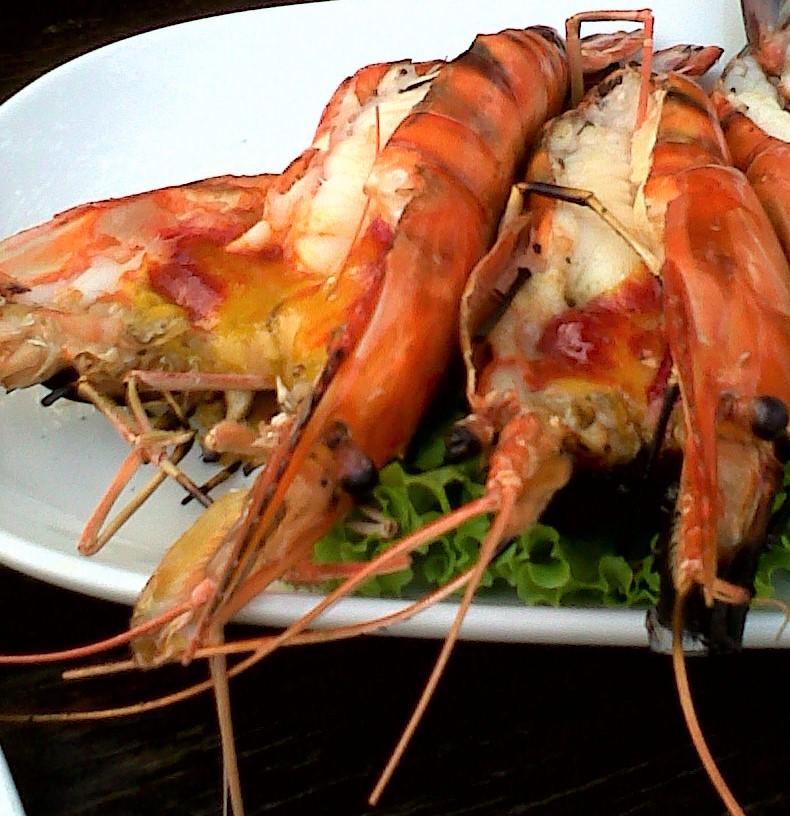An all-time popular species that has no rival is the river prawn. The best way to cook prawns is to grill them medium-rare with the heads full of shiny orange, liquid fat.
There is no need to cook them into a curry, stir-fried or deep-fried dish topped with chilli gravy because the spices will obscure the taste.
The aromatic flavour of river prawns and their creamy blob in the heads is unique. The sumptuous taste remains intact even when it is seasoned to be hot and spicy. Thus, it is not surprising why people prefer to have them grilled or made into hot and spicy tom yum.

Prawn salad.
Given the insatiable demand and the massive supply of prawns in the market every day, the question is where they come from. The answer to that question is that most prawns are farmed. The market prefers male prawns and farmers also want to raise males as they grow very fast and have firm, tasty meat. Most importantly, males require shorter-rearing time and fetch a good price. However, the challenge is how to convert all prawns cultured in the pond to males.
Thai biologists have found a hidden secret at the molecular level that can convert male prawns to females while retaining the male frame. The converted prawns retain their long claws, firm flesh comparable to the original, yet the male prawns can produce eggs and are propagatable. Apart from raising the prawn population, the biologists have conducted research on prawn nutrition to accelerate their growth at the least amount of cost.
Here comes the critical question though -- can authentic river prawns still be found in the wild? If so, how many exist in natural water sources?
River prawns only thrive in clean water with good circulation. They like to live along riverbanks due to favourable temperatures enhanced by trees which provide shade and the abundant availability of food which includes plants and small aquatic animals.

Grilled giant river prawns.
After mating, the females will spawn near the mouth of the river with salinity around 15%. Each female can carry as many as one million eggs, however, only 1% of those will survive. The newly hatched prawns feed on plankton, which are abundant in the estuarine area before finally swimming upstream during which time they may end up being preyed on by predators.
In the past, river prawns were caught along the banks of the Chao Phraya River in Nonthaburi and Pathum Thani up to Ayutthaya. Now there are almost no prawns in those areas. The female prawns die before they reach the mouth of the river in Phra Pradaeng during the course of their swim downstream via the klongs Bangsue, Banglampoo, Bangkok Noi and Sathon due to water pollution and the intensity of river traffic.
The Mae Klong River, which originates in Kanchanaburi, runs through large communities such as Kanchanaburi town, Ban Pong district and the Damnernsaduak floating market in the Photharam district of Ratchaburi. This is a major constraint to prawn survival as the majority can hardly make it to the estuarine area in Samut Songkhram and simply die as the river is not liveable.
Meanwhile, the Petchaburi River has helped to revive the prawn population to a certain extent as the water at the mouth of the river is slightly salty. During the rainy season, a massive amount of freshwater flushes into the river and as a result, the estuarine area shifts down to the Bang Taboon River, adjacent to the sea. In summer, the water becomes brackish which is favourable for the prawns to thrive in. Moreover, villagers in the area catch shrimp to earn a living. Also, the Department of Fisheries has educated farmers to raise gravid female prawns in cement ponds until the eggs hatch and then release the fry into the river. This practice should allow the prawn population to increase substantially in two years but unfortunately, some fishermen do not follow the advice as they sell the prawns right away despite knowing that they have been fertilised.
Another place you can find natural river prawns is the Trat River, Thailand's shortest river, which originates in Bantad Mountain in Cambodia. The river has a different setting from the aforementioned and there is no community alongside it. It also has a tribute called the Huay Raeng canal which is exemplary and a brackish area near Wat Huay Raeng is still pristine, which means large prawns are plenty there. Most villagers in the area catch prawns for household consumption only, with only a small number of fishermen catching prawns for sale.
The Huay Raeng canal is located just before KM 391 on the route to tambon Chang Kleur.

River prawn in spicy clear soup.
Yet another location to find river prawns is Klong Ta Tapao in Chumphon. It originates from the Tanaosri Mountain and passes through traditional mixed-crop orchards. As a result, the canal is clean with favourable conditions for prawns to survive in. The brackish water near Wat Khu Koot or Wat Suwan Nattee is abundant with prawns and villagers occasionally catch them for their own consumption as they can harvest marine fish easily in the surrounding areas.
Although there are restaurants in the area, none offer river prawn on the menu as there is no steady flow of supply.
There are many rivers which serve as a good habitat for river prawns. However, they are all facing environmental problems. If we want to eat natural river prawns, we need to help maintain the environment, otherwise we will have no choice but to buy farmed prawns.

